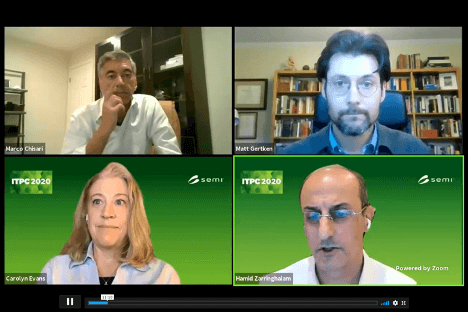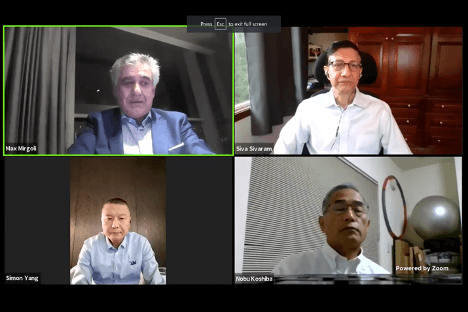The International Trade Partners Conference (ITPC 2020) was held virtually this year. The Tradewinds of Hawaii were missed, as well as the beach and personal interaction. SEMI did a good job developing relevant topics for leaders of companies in the time of geopolitical, geo-technical tensions, as well as creating content that was easy to digest and keep the audience engaged for three hours. SEMI seems to have a good handle on how to virtually present its tradeshows and conferences, and bring a bit of Hawaii into our screens.
The conference comprised three panels:
- Geopolitical/Economic Panel
- A Conversation on Future of Work, Business, Technology, and Innovation
- Executive Insight Panel: discussing Geopolitical Uncertainties, Trade Tensions and What Would the Semiconductor Industry’s Future Looks Like
Here, I summarized each panel. Over the next few weeks, we’ll run a blog series that dives deeper into the details of each.
Geopolitical/Economic Panel

In the Geopolitical Economic world, China and the United States continue to be on a collision course in trade due to the United States’ isolationist policies. These trends are unlikely to change with the next administration. The US needs to repair relationships with Europe so they don’t face a rising China – Russia trade partnership alone. Some of these trade decisions will be driven by the economic outlook which is still driven by the pandemic and at the moment predicted to have a W-shaped recovery. During the pandemic, technology facilitated the ability of most to maintain some sort of normalcy, with the ability to video conference. Unfortunately, the pandemic also accelerated the width of the digital divide, with those able to work and learn from home in a better economic situation than those who could not. The success of technology during the pandemic drove stock valuations to high levels and enable companies to have access to cheap money. The valuations and easy money have driven M&A activity to extremely active levels. China finds itself in a unique role in the approval process. China will need to be very strategic in this role; otherwise they could find themselves in an isolationist role themselves.
Future of Work Panel

The future of work will take the best of work at work, and the best of work from home and integrate the two to have the best of both worlds. However, with video conferencing it is difficult to see and judge body language, or if people are paying attention. Dr. King-Liu pointed out that colleges had pivoted quickly to create new materials that would better engage students, and that this process was ongoing. The industry has yet to adopt these techniques so it will be interesting to see if the industry starts to collaborate with academia on how to better deliver content to participants. All panelists miss the face-to-face collaboration and feel that face-to-face interaction is critical to successful technological advancements. But, since video conferencing is here to stay, advances in video technology are needed, better bandwidth, 3D imaging, and the ability to determine a person’s emotions and how attentive the persons in the discus are. Some of these capabilities are emerging, but there is still a way to go to improve the capabilities of video conferencing.
Executive Insights Panel

The Executive insights panel tackled Geopolitical trade issues, tensions, and what the industry might look like in the future. They covered a great deal of ground during the discussion. The key challenges in the near future are that due to the geopolitical geotechnical climate the supply chain could become extremely fragmented and companies will need to be very agile to deal with the changes. The geopolitical trade shifts are creating a more regionalized market which is more difficult to serve as potentially each region will have different requirements and standards. This creates challenges for companies and they will need to be able to look for ways to leverage their R&D and final products. Koshiba-san suggested selling outcomes instead of products, somewhat akin to selling software or products as a service, as well as looking for parallel markets for your products generate maximize your operations return on investment. All three panelists predicted that the industry is in a good place due to the growth of AI and 5G, as heterogeneous compute moves to where the data is generated. However, the growth of EUV and data centers has a downside as they are consuming considerably more power than in the past. The industry needs to look at how to reduce its carbon footprint and continue to become more sustainable in the future. They also reminded the audience that relationships and the trust developed in those relationships were critical factors in helping the industry in the current geopolitical technical climate.
In three hours, ITPC 2020 did a great job of defining some of the issues facing the semiconductor industry. The current geopolitical environment, tensions, and the resulting trade laws are resulting in a fragmented supply chain and in some cases tension between former trade partners. The Pandemic is forcing the industry to find new ways of looking at how to work. The new normal may include both remote work as well as face to face. Many of the participants commented that the face to face interaction is critical to the innovation that keeps the industry rapidly moving forward. However, even with all of the challenges, the outlook was very positive. Participants stated that as a result of 5G and AI implementations were key drivers for growth as computing moves closer to the data, However, the Semiconductor industry does need to pay close attention to sustainability as technology continues to move forward. Relationships are key, as most speakers lamented not being able to see and interact face to face with each other. Hopefully next year the conference will be able to return to Hawaii, but until then we have SEMI to help keep the industry connected with video conferencing.



















